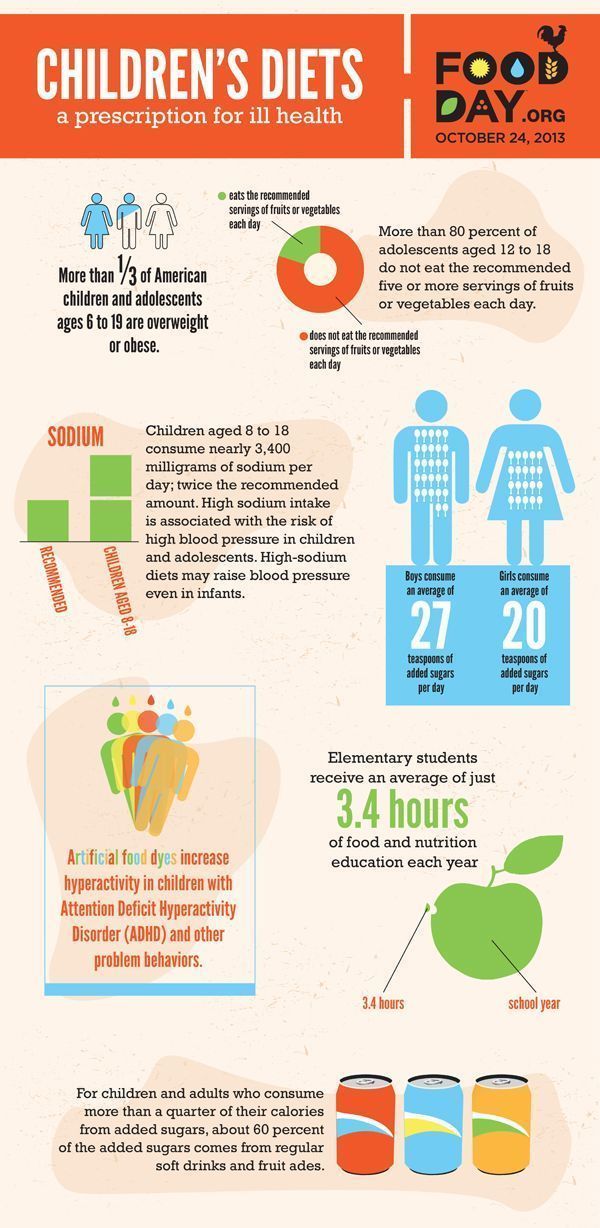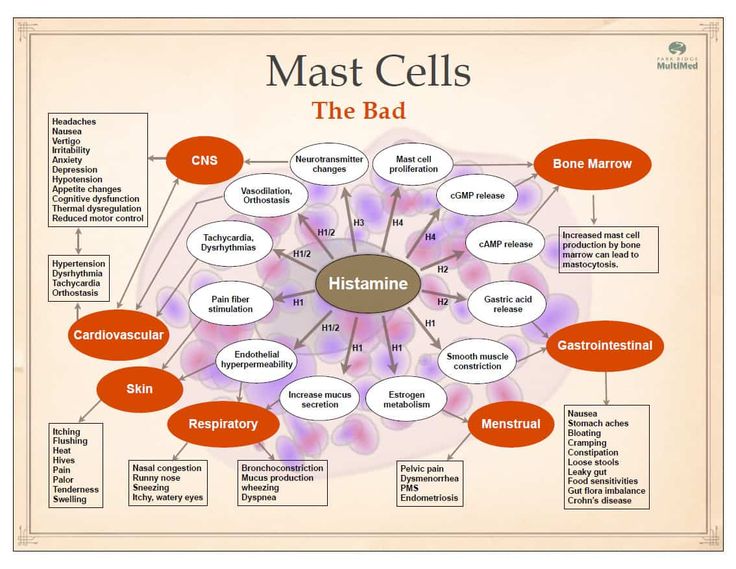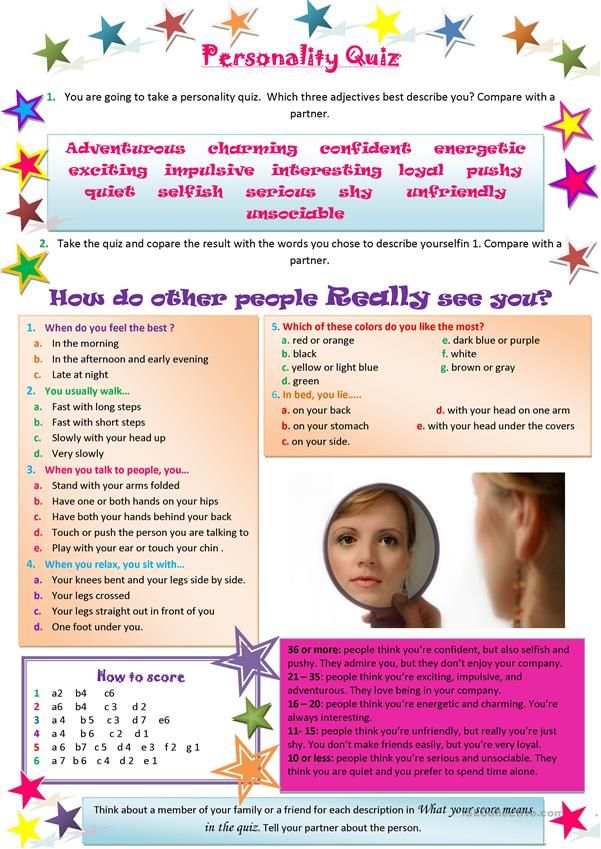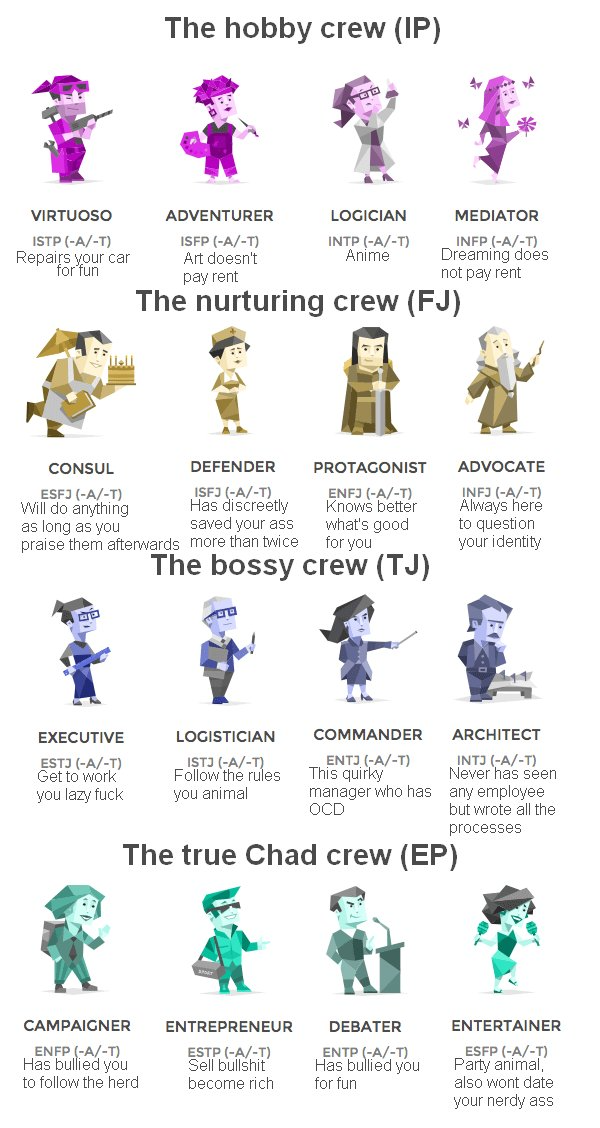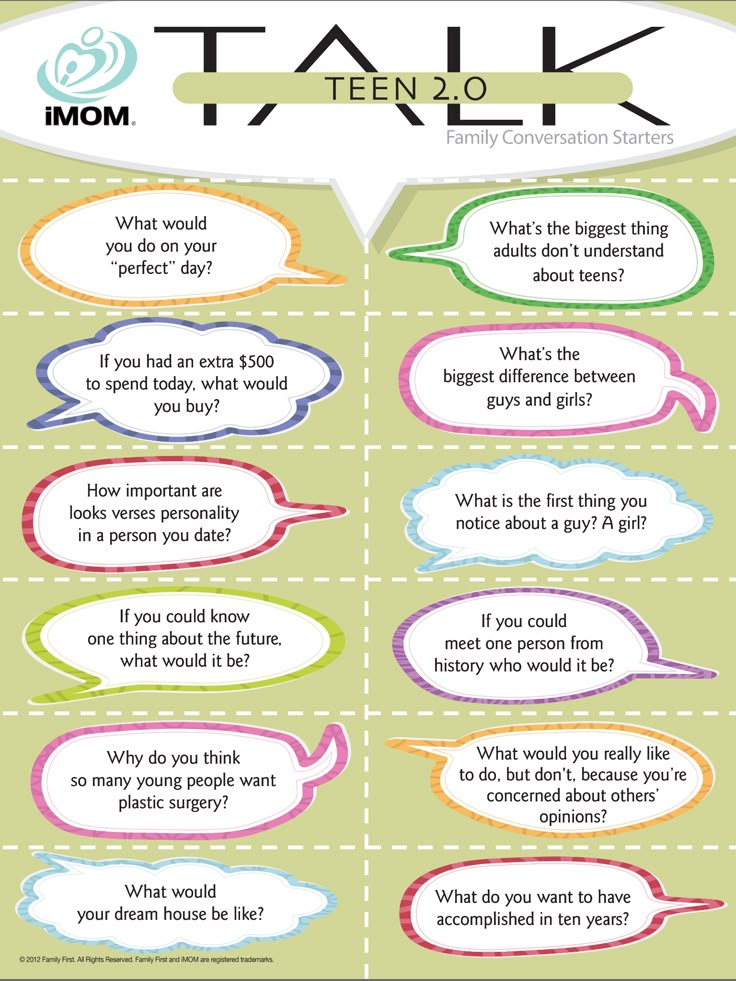Red food dye and adhd
List of foods, symptoms, and more
Red dye 40 is a synthetic food dye. This and other dyes may worsen the symptoms of attention deficit hyperactivity disorder (ADHD) in some children with the condition, but more research is needed.
Researchers have extensively looked at the connection between diet and ADHD. Although data suggest that food dyes increase ADHD symptoms, they only seem to do so by a small amount. However, some children may be more sensitive to their effects than others.
Keep reading to learn about what red dye 40 is, how to find it on food labels, and how it can affect children with ADHD.
Red dye 40 is a commonly used synthetic food dye made from petroleum.
It is one of nine certified color additives that the Food and Drug Administration (FDA) has approved for use in food and beverages. Manufacturers use synthetic color additives more often than natural options because they provide a more uniform color, do not add unwanted flavors, and are generally cheaper.
Food manufacturers can only use synthetic additives that the FDA has certified. Natural color additives, which are pigments from vegetables, minerals, and animals, are exempt from certification. However, the FDA must still approve them for use.
Red dye 40 is one of the most commonly used color additives. It is present in many foods and beverages, including:
- energy and sports drinks
- soda
- protein powders
- cereals
- dairy products
- gelatins
- candy
- chewing gum
- confections
A person can identify whether a food or beverage contains red dye 40 by reading the ingredients list. Although manufacturers are not required to disclose the amount of a listed ingredient present in the product, they must list the ingredients by weight.
The ingredients labels on packaged foods and drinks may sometimes list red dye 40 by one of its other names, which include:
- Allura Red AC
- Red 40
- Red 40 Lake
- FD&C Red no.
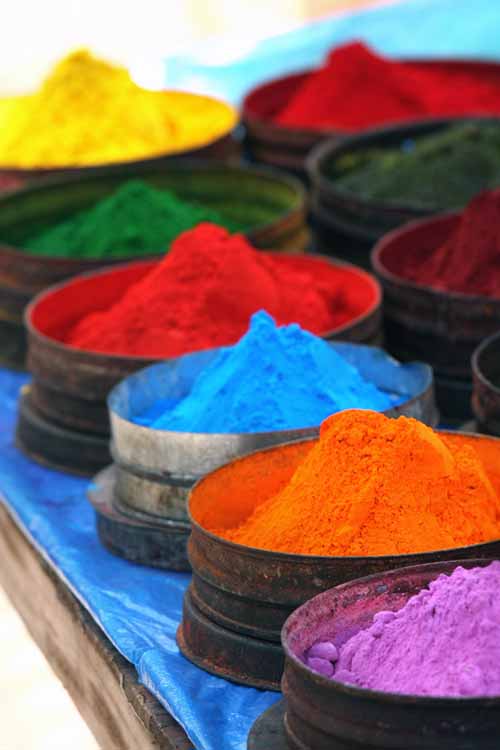 40 Aluminum Lake
40 Aluminum Lake - FD&C Red no. 40
- E129
- CI Food Red 17
- INS no. 129
Research in both animals and humans has shown synthetic color additives such as red dye 40 to have links to ADHD symptoms and other neurobehavioral conditions.
In 2011, the FDA said that synthetic color additives had no adverse effects. However, research has since shown that they can cause ADHD symptoms and that some children are particularly sensitive to their effects.
According to a 2021 report from the state of California, research does indicate that children who consume synthetic food dyes, including red dye 40, can experience hyperactivity and other neurobehavioral issues.
Experts believe that red dye 40 and other synthetic color additives may cause behavioral changes due to:
- a depletion of minerals that play a role in growth and development, including zinc and iron
- chemical changes in the brain
- hypersensitivity, which causes allergic reactions such as inflammation
Many studies on synthetic color additives look at red dye 40. Although the data vary, the majority of studies report at least some connection between color additives and ADHD symptoms.
Although the data vary, the majority of studies report at least some connection between color additives and ADHD symptoms.
Sensitivity to food dyes varies from one person to another, but most research has focused on children. Adverse effects can occur in children with and without preexisting behavioral conditions, such as ADHD.
Hyperactivity symptoms can include:
- constant fidgeting
- an inability to concentrate
- being unable to sit still
- excessive movement
- an inability to wait their turn
- interrupting conversations
- little or no sense of danger
In adults, hyperactivity symptoms may also include restlessness and excessive talking.
Research indicates that hyperactivity in some children may increase due to exposure to synthetic food dyes, including red dye 40.
People often assume that sugar consumption, especially in children, can lead to an increase in ADHD symptoms, such as hyperactivity and inattention.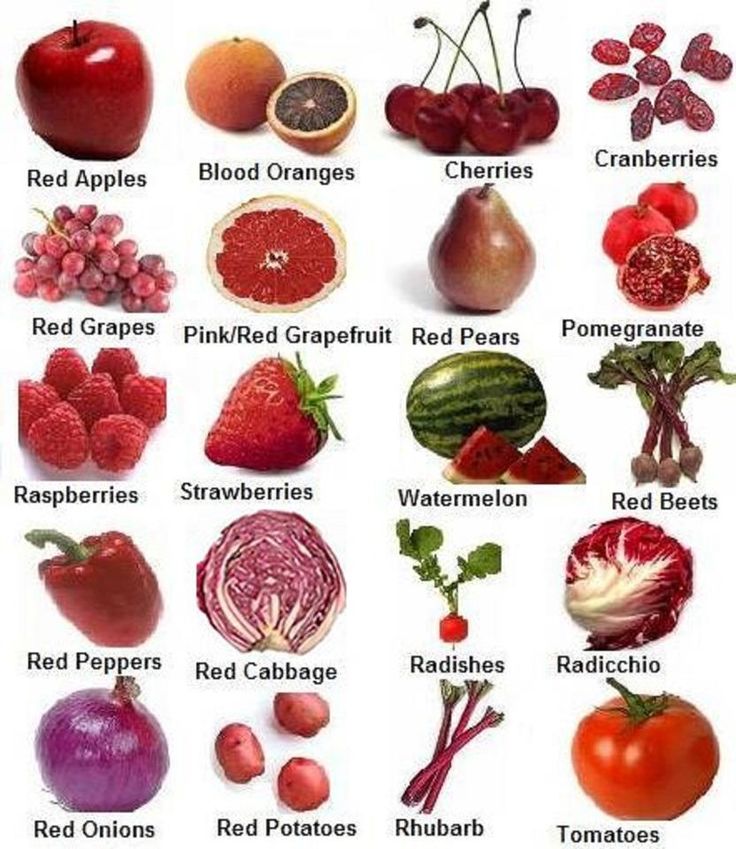
However, there are mixed study findings on whether sugar and ADHD are related.
According to a 2019 study in the Journal of Affective Disorders, there is some evidence that a diet high in refined sugar and saturated fat increases the risk of ADHD. However, the authors say that the current evidence, which relies primarily on observational studies, is weak and that more research is necessary.
A 2020 study in Complementary Therapies in Medicine suggests that there may be a relationship between sugar consumption and ADHD symptoms. However, another 2019 study found that there was no link between sucrose, a type of sugar, and ADHD incidence in children.
Although there is a need for more studies to determine the effects of sugar on ADHD symptoms, most research suggests that there is a link between food dyes and hyperactivity. This is especially true of the widely studied food dyes, including red no. 3, red dye 40, and yellow no. 5.
Red dye 40 is a synthetic food dye made from petroleum.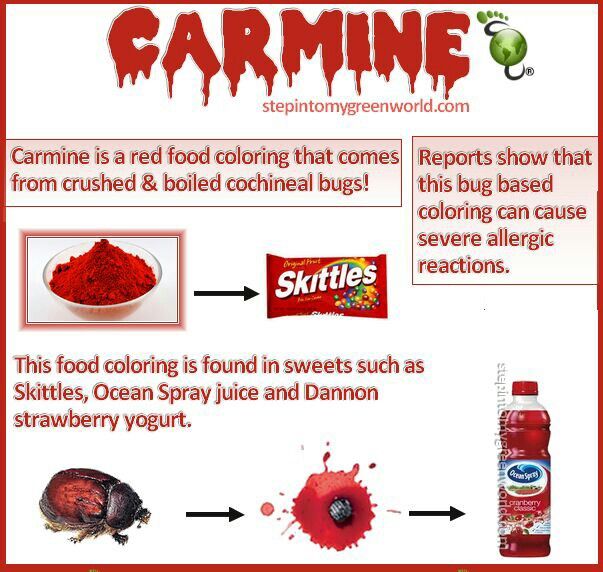 Research has shown that it is linked to certain ADHD symptoms, such as hyperactivity, and may also cause other neurobehavioral effects in children.
Research has shown that it is linked to certain ADHD symptoms, such as hyperactivity, and may also cause other neurobehavioral effects in children.
People can check for red dye 40 on food labels if they wish to limit their intake. It is important to note that it may go by other names, including Allura Red AC, Red 40, Red 40 Lake, FD&C Red no. 40 Aluminium Lake, and FD&C Red no. 40.
Food Coloring, Sugar, and Diet
Written by WebMD Editorial Contributors
In this Article
- Can food dye cause hyperactivity?
- What is in food dye?
- Does sugar cause symptoms of ADHD?
For more than 30 years, scientists have examined the relationship between food coloring and hyperactive behavior in children, but with mixed results. To date, no conclusive evidence has been found to show that food coloring causes ADHD. Some studies, though, have suggested an association between the two. Most likely, ADHD is caused by the combination of changes in brain structure, environmental factors, and heredity.
Can food dye cause hyperactivity?
A study of nearly 300 children by the United Kingdom’s Food Standards Agency in 2007 showed that the consumption of foods containing dyes could increase hyperactive behavior in children. In the study of 3-, 8- and 9-year-olds, children were given three different types of beverages to drink. Then their behavior was evaluated by teachers and parents.
One of the drink mixtures contained artificial food colorings, including:
- Sunset yellow (E110)
- Carmoisine (E122)
- Tartrazine (E102)
- Ponceau 4R (E124)
It also contained the preservative sodium benzoate. The second drink mixture included:
- Quinoline yellow (E104)
- Allura red (E129)
- Sunset yellow
- Carmoisine
It also had sodium benzoate. The third drink mixture was a placebo and contained no additives.
The researchers found that hyperactive behavior by the 8- and 9-year-olds increased with both the mixtures containing artificial coloring additives.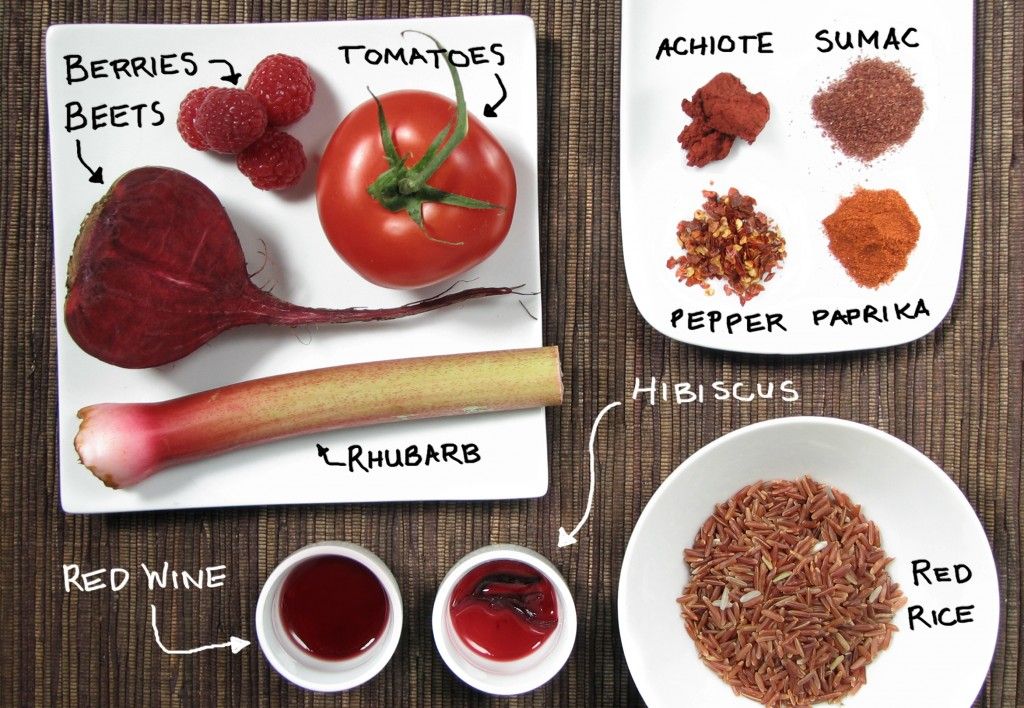 The hyperactive behavior of 3-year-olds increased with the first beverage but not necessarily with the second. They concluded that the results show an adverse effect on behavior after consumption of the food dyes.
The hyperactive behavior of 3-year-olds increased with the first beverage but not necessarily with the second. They concluded that the results show an adverse effect on behavior after consumption of the food dyes.
What is in food dye?
Food coloring consists of chemicals used to add color to food. Food coloring (dye) is often added to processed foods, drinks, and condiments. They are used to maintain or improve the appearance of the food.
Manufacturers usually add dye for the following reasons:
- To add color to colorless foods
- To enhance colors
- To avoid color loss due to environmental elements
- To provide consistency when there are variations in the coloring of the food
The FDA regulates color additives to ensure that they are safe for human consumption. Regulation also helps ensure that foods with coloring are accurately labeled so that consumers know what they are eating. To determine the approval of an additive, the FDA studies the composition of it and how much is consumed and notes any health effects and safety factors that need to be observed. Once the food dye is approved, the FDA determines an appropriate level of use for that additive. The FDA only allows an additive to be approved if there is a reasonable certainty of no harm to consumers.
Once the food dye is approved, the FDA determines an appropriate level of use for that additive. The FDA only allows an additive to be approved if there is a reasonable certainty of no harm to consumers.
There are two types of approved color additives - dyes and lakes. Dyes are water-soluble and usually come in the form of powders, granules, or liquids. Lakes are not water-soluble. They are found in products containing fats and oils.
Some food colorings are synthetically produced. Examples of these color additives include FD&C Blue Nos. 1 and 2, FD&C Green No. 3, and FD&C Red No.40. Other food colorings come from pigments of vegetables, minerals, or animals. Examples of these natural additives include beta-carotene, grape skin extract, caramel color, and saffron.
Does sugar cause symptoms of ADHD?
Processed sugars and carbohydrates may have an effect on a child’s activity level. These sugars produce a rapid increase in blood glucose levels because they enter the bloodstream so quickly.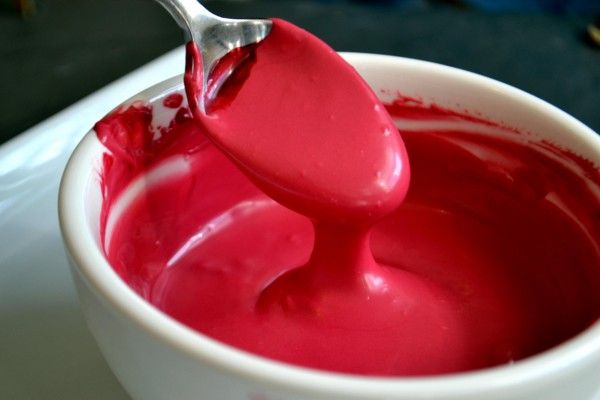 A child may become more active due to an adrenaline rush produced by this blood sugar spike.
A child may become more active due to an adrenaline rush produced by this blood sugar spike.
Decreased activity in the child is sometimes noted as the adrenaline levels fall. However, there has been no proof to date that sugar actually causes ADHD.
Food colorings: harmless or harmful?
Artificial food colors are responsible for the vibrant colors of candies, sports drinks and baked goods.
They are even used in some brands of pickles, smoked salmon and salad dressings, and in medicines.
In fact, the consumption of artificial colors in food has increased by 500% in the last 50 years, and children are the largest consumers (1, 2, 3).
Artificial colors are said to cause serious side effects such as hyperactivity in children, as well as cancer and allergies. nine0003
The topic is very controversial and there are many conflicting opinions about the safety of artificial colors for food. This article separates fact from fiction.
content
What are the colors of food?
Food colorings are chemicals that have been developed to improve the appearance of food by giving it an artificial color.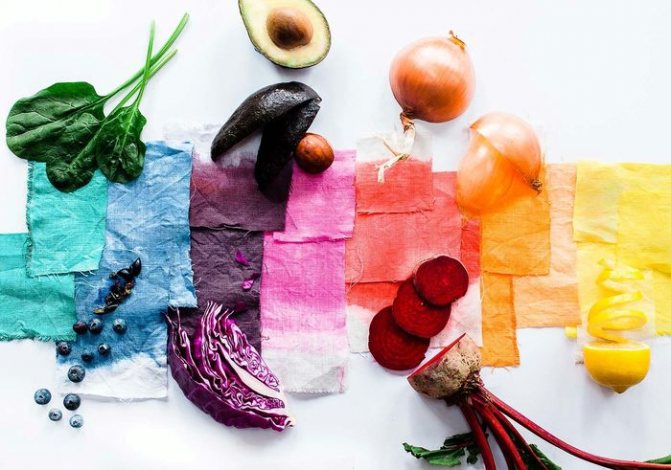
People have been adding food coloring for centuries, but the first artificial food coloring was created in 1856 from coal tar. nine0003
Today, food coloring is made from oil.
Hundreds of artificial food colors have been developed over the years, but most have since proven to be poisonous. There are only a few artificial colors that are still used in food today.
Food manufacturers often prefer artificial food colors over natural food colors such as beta-carotene and beetroot extract because they produce a brighter color. nine0003
However, there is much controversy regarding the safety of artificial food colors. All artificial colors currently used in food have been tested for toxicity in animal studies.
Regulators such as the US Food and Drug Administration (FDA) and the European Food Safety Administration (EFSA) have concluded that dyes do not pose a significant health risk. nine0003
Not everyone agrees with this conclusion. Interestingly, some food colorings are considered safe in one country but banned for human consumption in another, making them very confusing when assessing their safety.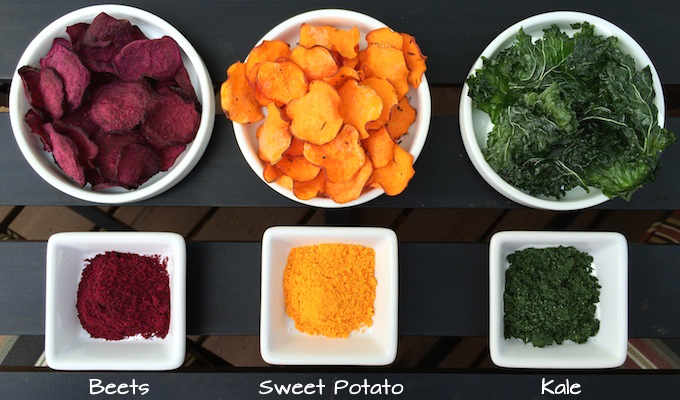
Artificial Colors Currently Used in Foods
The following color products are approved for use by the EFSA and FDA (4, 5):
- Red no. 3 (Erythrosine): A cherry red color commonly used in candies, beans, and cake decorating gels. nine0038
- Red no. 40 (Allura Red): A dark red color used in sports drinks, sweets, spices, and cereal.
- Yellow no. 5 (Tartrazine): Lemon yellow found in sweets, soft drinks, chips, popcorn, and cereal.
- Yellow no. 6 (sunset): orange-yellow is used in sweets, sauces, baked goods, and canned fruits.
- Blue no. 1 (bright blue): A greenish blue color used in ice cream, canned peas, packaged soups, legumes, and glazes. nine0038
- Blue no. 2 (Indigo Carmine): A bright blue color found in sweets, ice cream, cereals and snacks.
The most popular food colors are Red 40, Yellow 5 and Yellow 6. These three colors make up 90% of all food coloring used in the United States (3).
Several other colors have been approved in some countries but banned in others.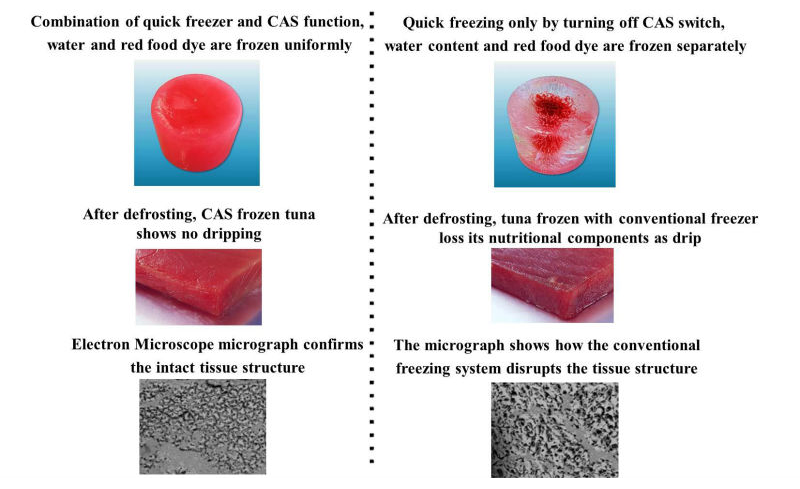 Green no. 3, also known as Fast Green, is FDA approved but banned in Europe.
Green no. 3, also known as Fast Green, is FDA approved but banned in Europe.
Quinoline yellow, carmoisine and ponceau are examples of food colorings that are allowed in the EU but banned in the US.
Food coloring can cause hyperactivity in sensitive children
In 1973, a pediatric allergist stated that artificial colors and food preservatives were causing hyperactivity and learning problems in children.
At the time, there was very little scientific evidence to support his claim, but many parents accepted his philosophy. nine0003
A doctor introduced an elimination diet for attention deficit hyperactivity disorder (ADHD). The diet excludes all colors of artificial foods, as well as several other artificial ingredients.
One of the earliest studies, published in 1978, found no change in children's behavior when given a dose of artificial food coloring.6).
Since then, several studies have found a small but significant association between artificial colors and food and hyperactivity in children.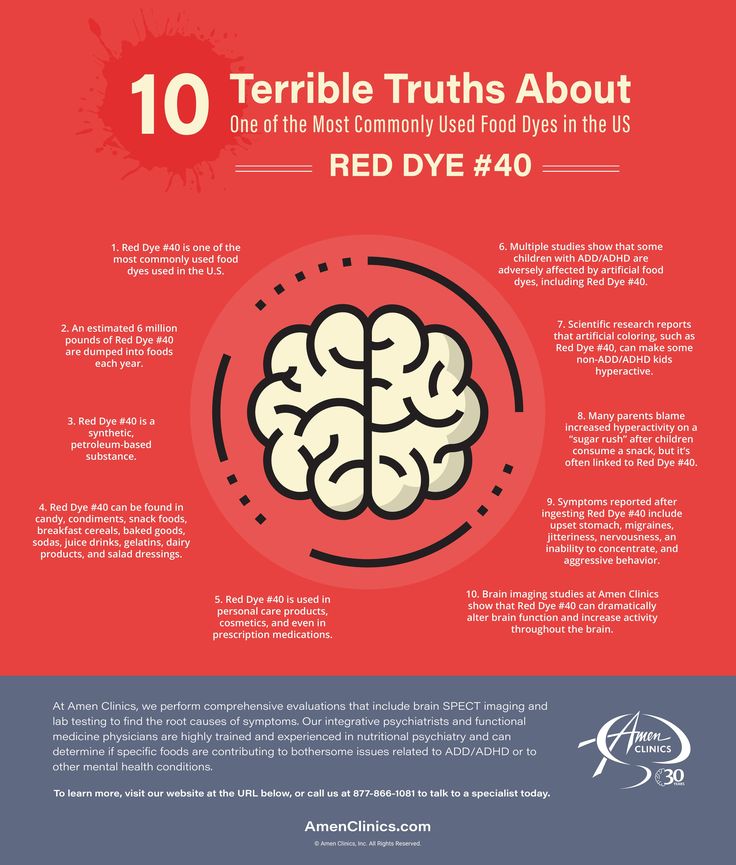 1). nine0003
1). nine0003
One clinical study found that removing artificial food colors from the diet, along with a preservative called sodium benzoate, significantly reduced symptoms of hyperactivity.7).
A small study found that 73% of children with ADHD experienced a reduction in symptoms after the removal of artificial colors and food preservatives.8).
Another study showed that food coloring, along with sodium benzoate, increased hyperactivity in both 3-year-olds and 3- to 8-year-olds.9).
But because these study participants were given a mixture of ingredients, it is difficult to determine what caused the hyperactivity.
Tartrazine, also known as yellow 5, has been associated with behavioral changes including irritability, anxiety, depression, and sleep problems.10).
Moreover, a 2004 study from the 15th study concluded that artificial food colors increase hyperactivity in children (11).
However, not all children react the same way to food coloring.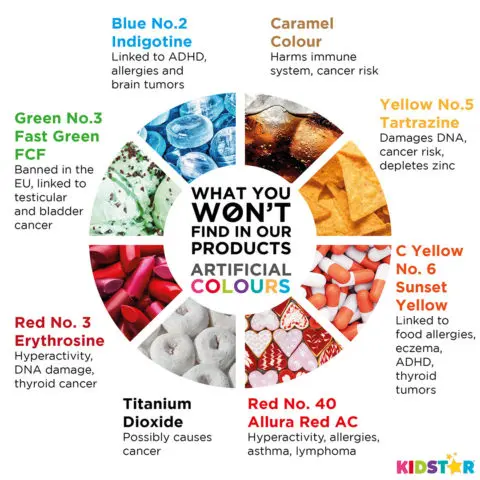 Researchers at the University of Southampton have discovered a genetic component that determines how food coloring affects a child.12). nine0003
Researchers at the University of Southampton have discovered a genetic component that determines how food coloring affects a child.12). nine0003
Although the effects of food coloring have been observed in children with and without ADHD, some children appear to be much more sensitive to color than others.1).
However, both the FDA and EFSA have stated that there is currently insufficient evidence to conclude that artificial food colors are unsafe.
Their regulators assume that a substance is safe until proven harmful. However, the evidence is certainly enough to raise concerns. nine0003
Interestingly, in 2009 the British government began to encourage food manufacturers to look for alternatives to food coloring. Since 2010, the UK has required labeling warnings for any food containing artificial food coloring.
Do food colorings cause cancer?
The safety of artificial food colors is highly controversial.
However, studies evaluating the safety of food coloring are long-term animal studies.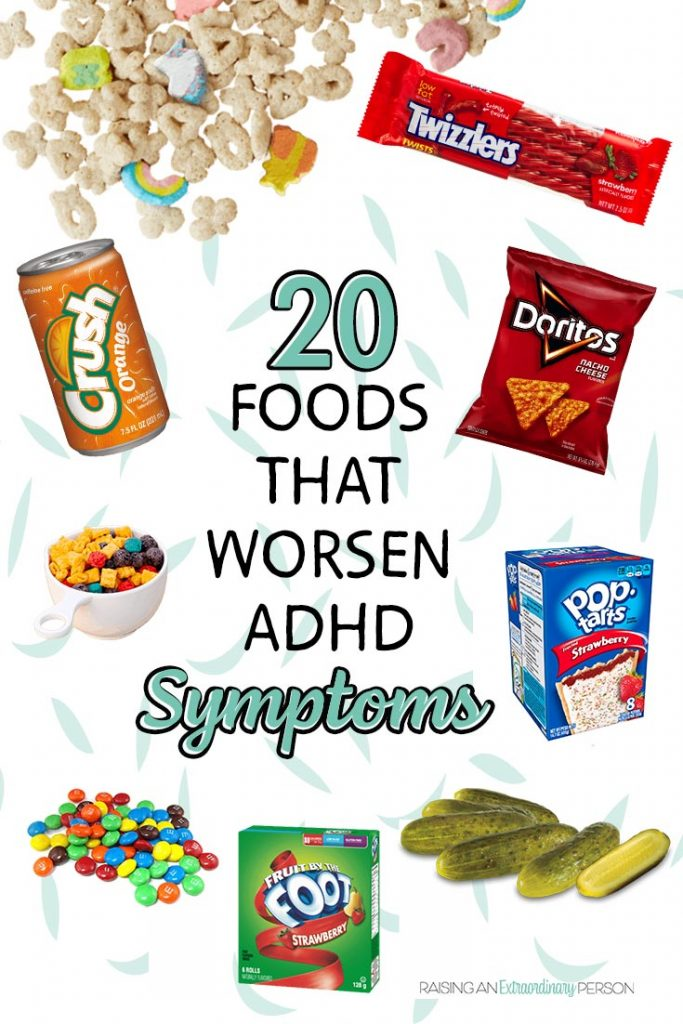 nine0003
nine0003
Interestingly, studies using blue 1, red 40, yellow 5, and yellow 6 found no evidence of carcinogenic effects.13, 14, 15, 16, 17, 18, 19).
However, other colors may cause more concern.
Concerns about blue 2 and red 3
An animal study of blue 2 found a statistically significant increase in brain tumors in the high dose group compared to control groups, but the investigators concluded that there was insufficient evidence to determine whether whether blue 2 causes tumors.20). nine0003
Other studies on blue 2 have shown no side effects (21, 22).
Erythrosine, also known as Red 3, is the most controversial color. Male rats given erythrosin were at increased risk of developing thyroid tumors.23,24).
Based on this study, the FDA partially banned erythrosin in 1990, but later removed the ban. After reviewing the results of the study, they concluded that thyroid tumors were not caused directly by erythrosin.24, 25, 26, 27). nine0003
In the US, Red 3 has been largely replaced by Red 40, but is still used in maraschino cherries, candies, and legumes.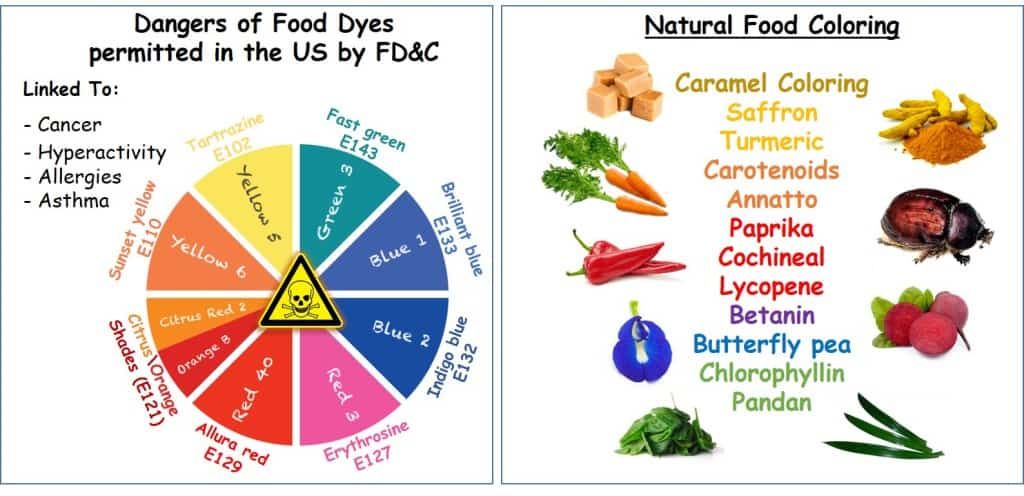
Some paints may contain contaminants that cause cancer.
Although most food colors have not been shown to cause side effects in toxicity studies, there are concerns about potential color contamination (28).
Red 40, Yellow 5 and Yellow 6 may contain known carcinogens. Benzidine, 4-aminobiphenyl, and 4-aminoazobenzene are potential carcinogens found in food coloring (3, 29, 30, 31, 32).
These contaminants are allowed in colors because they are present in low amounts that are considered safe (3).
More research needed
The use of artificial colors in food is on the rise, especially among children. Eating too many foods that contain contaminants can be a health hazard.
However, with the exception of Red 3, there is currently no conclusive evidence that artificial food colors cause cancer. nine0003
However, keep in mind that most of the safety studies on food coloring were conducted decades ago.
Since then, the consumption of food coloring has increased dramatically, and often several different food colorings are combined in food along with other preservatives.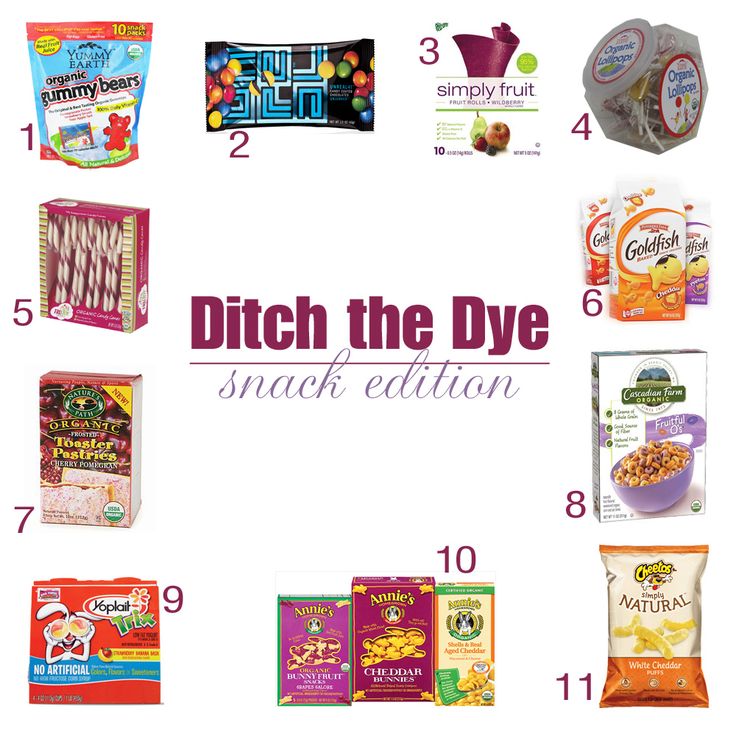
Does food coloring cause allergies?
Some artificial food colors may cause allergic reactions (28, 33, 34, 35).
Yellow 5, also known as tartrazine, has been shown in several studies to cause rashes and asthma symptoms.36, 37, 38, 39).
Interestingly, people allergic to aspirin are more likely to be allergic to yellow 5.37, 38).
In a study of people with chronic rashes or swelling, 52% had an allergic reaction to artificial food colors (40).
Most allergic reactions are not life threatening. However, if you have allergy symptoms, it may be helpful to eliminate artificial colors from your diet.
Red 40, yellow 5 and yellow 6 are among the most commonly consumed colors and are the three most likely to cause an allergic reaction.3). nine0003
Should food coloring be avoided?
The most current claim about artificial food colors is that they cause cancer.
However, the evidence to support this claim is weak. Based on currently available research, it is unlikely that consumption of food coloring will cause cancer.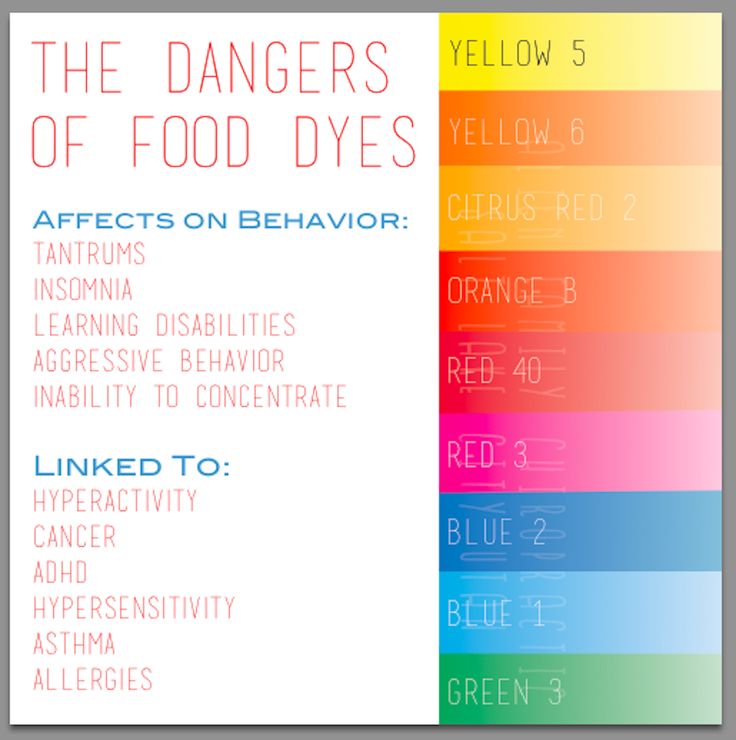
Some food colors cause allergic reactions in some people, but if you don't have allergy symptoms, there is no reason to cut them out of your diet. nine0003
The food coloring claim that has the strongest science in this regard is the link between food coloring and hyperactivity in children.
Several studies have shown that food coloring increases hyperactivity in children with and without ADHD, although some children appear to be more sensitive than others.1).
If your child has hyperactive or aggressive behavior, it may be helpful to eliminate artificial food colors from their diet. nine0003
The reason colors are used in food is because the food looks more attractive. Food coloring has absolutely no nutritional value.
However, there is not enough evidence to suggest that artificial food coloring should be avoided by everyone.
A healthy diet always helps. The biggest sources of food coloring are unhealthy processed foods, which have other negative health effects.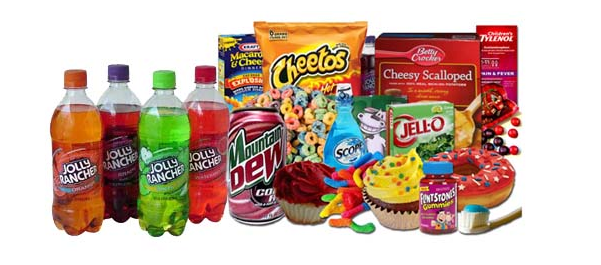 nine0003
nine0003
Removing processed foods from your diet and switching to healthy whole foods will improve your overall health and drastically reduce your consumption of artificial food colors in the process.
Healthy whole foods are inherently colorless
The best way to eliminate artificial food colors from your diet is to focus on eating whole, unprocessed foods.
Unlike processed foods, most whole foods are very nutritious. nine0003
Here are some foods that are naturally color-free:
- Dairy and eggs: milk, plain yogurt, cheese, eggs, cottage cheese.
- Meat and poultry: fresh unmarinated chicken, beef, pork and fish.
- Nuts and seeds: almonds, almonds, macadamia nuts, cashews, pecans, walnuts, sunflower seeds.
- Fresh fruits and vegetables: all fresh fruits and vegetables.
- Cereals: oats, brown rice, quinoa, barley. nine0038
- Legumes: black beans, kidney, chickpeas, sailor beans, lentils.
If you want to eliminate all colors from your diet, always read the label before eating any food. Some seemingly healthy foods contain artificial food coloring.
Some seemingly healthy foods contain artificial food coloring.
Accept home message
There is no conclusive evidence that food coloring is harmful to most people.
However, it may cause allergic reactions and hyperactivity in some people. nine0003
However, most food coloring is found in unhealthy processed foods that should be avoided anyway.
Instead, focus on eating whole, nutritious foods that are naturally colorless.
Ordinary food dyes can provoke inflammatory bowel disease
Health and medicineNews
The proliferation of nutritional supplements has many scientists worried about the long-term effects on human health. There is growing evidence that diet plays a central role in the development of inflammatory bowel diseases such as ulcerative colitis and Crohn's disease. Recently, researchers have shown that long-term use of the commonly used food coloring Red Alluring AC (E129), found in children's products in particular, is a potential trigger for these diseases.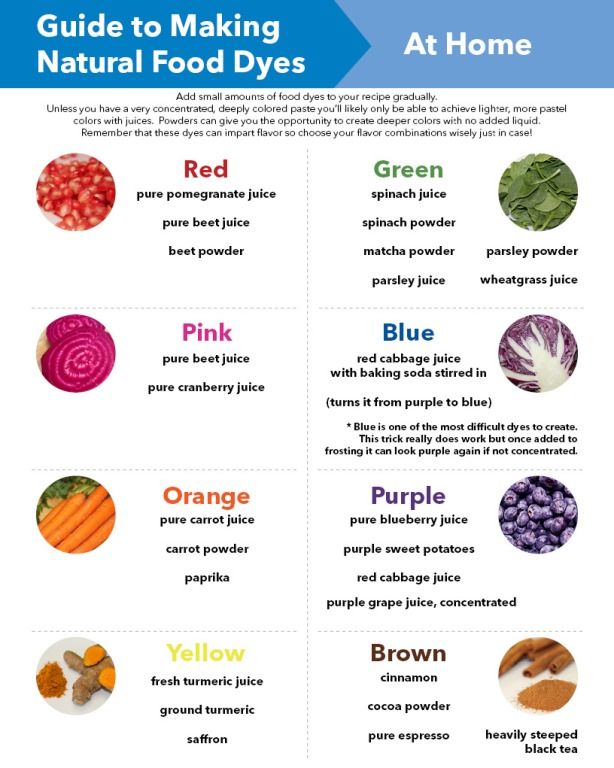 nine0003
nine0003
Environmental factors play an important role in the development of many inflammatory and autoimmune diseases, in particular inflammatory bowel diseases, including Crohn's disease and ulcerative colitis. These are serious chronic inflammatory diseases of the gastrointestinal tract that affect millions of people around the world.
Genetic predisposition, inappropriate immune response to disrupted gut microbiota and environmental factors have been shown to contribute to their occurrence. Therefore, it is easy to understand that food plays a central role, especially in Western countries. nine0003
Typically, the Western diet is characterized by high consumption of food additives, fats, red meat and sugar and low fiber intake, which provokes chronic intestinal inflammation. Food additives such as emulsifiers, stabilizers, and synthetic colors are widely used to improve the texture, shelf life, and aesthetics of processed foods.
A number of studies have reported that high levels of these additives, such as maltodextrin and titanium dioxide, as well as ingredients added during food processing, including food emulsifiers and artificial sweeteners, alter the gut microbiota. They increase intestinal permeability and reduce the thickness of the mucosal barrier, thereby promoting inflammation. nine0003
They increase intestinal permeability and reduce the thickness of the mucosal barrier, thereby promoting inflammation. nine0003
In this context, a team of researchers from McMaster University (Canada) found that chronic exposure to Red Alluring AC (E129) damages gut health and promotes inflammation by directly disrupting the function of this barrier.
Overused Synthetic Food Coloring
The use of synthetic food colorings has exploded in recent decades, but there has been little research into their effects on the gut and overall health. nine0003
This is because these compounds are metabolized to form free aromatic amines in the intestinal lumen, some of which are potentially carcinogenic and mutagenic. Among them, AC Charm Red (FD&C Red 40 or E129) is the most widely used dye in many countries. It can be found in commonly consumed foods intended for children (eg breakfast cereals, drinks and confectionery).
In addition, previous studies have shown that this dye has a pro-inflammatory effect in the liver and kidneys of the studied rats.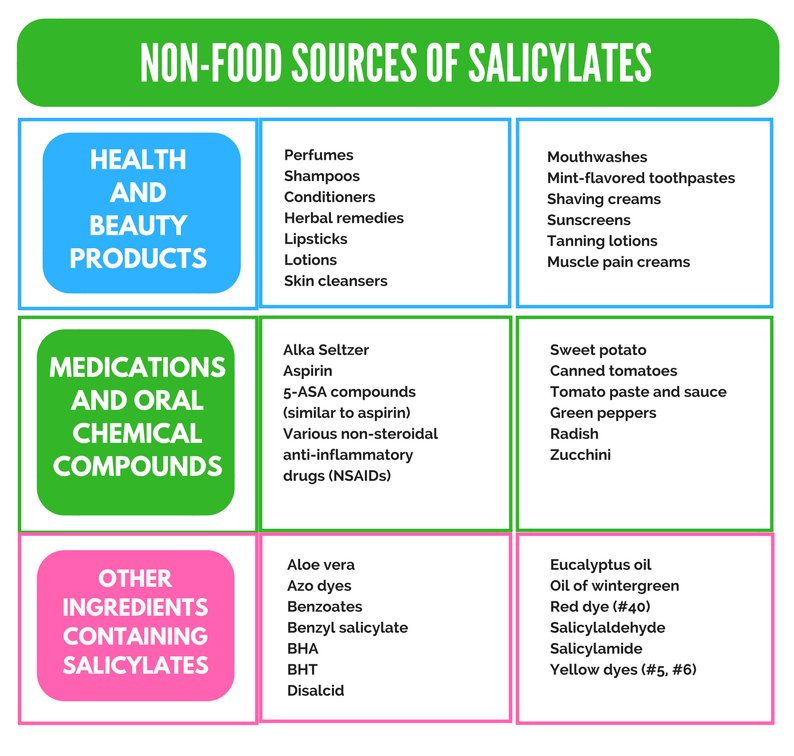 A dose of 10 mg/kg body weight, administered orally to mice, resulted in significant DNA damage in their colons. Although it is widely consumed in our diet, researchers still don't fully understand how it affects gut inflammation. nine0003
A dose of 10 mg/kg body weight, administered orally to mice, resulted in significant DNA damage in their colons. Although it is widely consumed in our diet, researchers still don't fully understand how it affects gut inflammation. nine0003
Episodic consumption without consequences?
Researchers have found that chronic exposure to E129 is detrimental to gut health and promotes inflammation. The dye directly disrupts the function of the intestinal barrier and increases the production of serotonin, a hormone (neurotransmitter) found in the gut, which subsequently changes the composition of the gut microbiota, resulting in increased sensitivity.
Valiul Khan, lead author of the study, professor in the Department of Pathology and Molecular Medicine and senior research fellow at the Farncombe Family Digestive Health Research Institute, explains in a statement: " This study demonstrates the significant negative effects of E129 on gut health and identifies gut serotonin as a critical factor mediating these effects.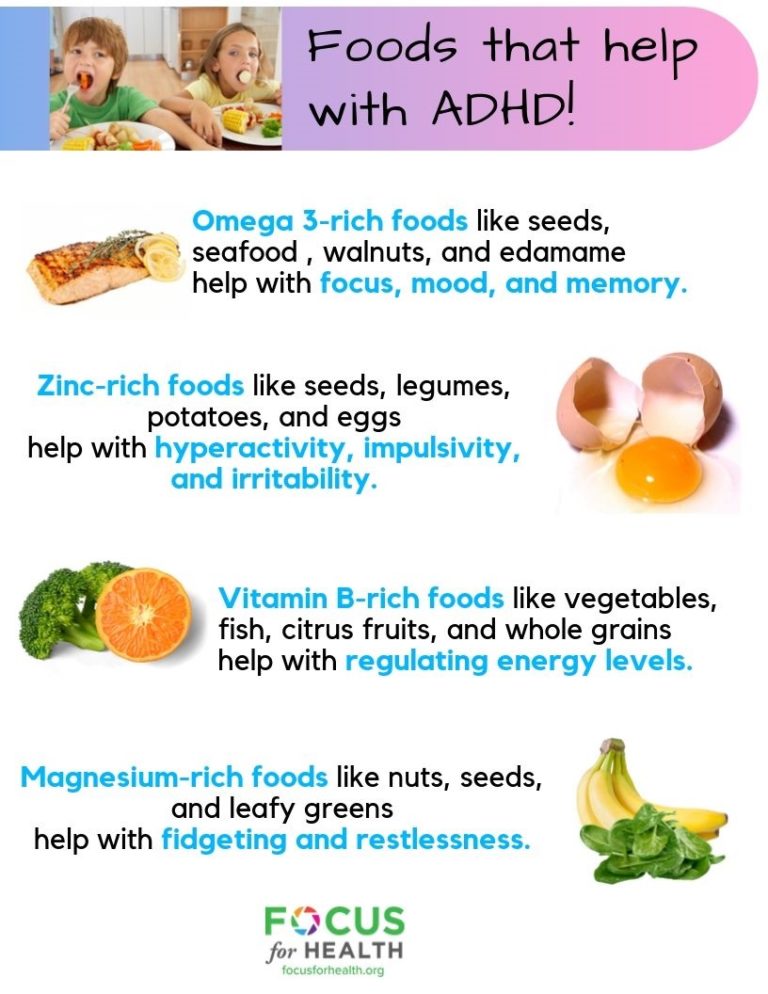 These results are important for the prevention and treatment of inflammatory bowel disease.
These results are important for the prevention and treatment of inflammatory bowel disease.
Although intermittent exposure in mice (similar to typical human exposure) for 12 weeks does not affect susceptibility to colitis, early exposure makes mice more susceptible to colitis. nine0003
Waliul Khan says: " What we found is startling and alarming as this common synthetic food coloring is a potential dietary trigger for inflammatory bowel disease. This study is a significant step forward in alerting the public to the potential harms of the food coloring we consume daily ". He also added: " Literature suggests that E129 consumption also affects certain allergies, immune disorders, and behavioral problems in children, such as attention deficit disorder with or without hyperactivity ".
In recent years, significant progress has been made in identifying susceptibility genes and understanding the role of the immune system and microbiota in the development of inflammatory bowel disease.